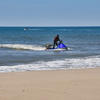Shoreface Morphology and Geology
Exchanges of sediment between the shoreface and barrier islands allow barrier islands to adjust to changes in water level, such as those associated with storms or sea-level rise. Characterizing shoreface morphology and geology allows us to explore how past and present processes have impacted modern barrier island sediment transport and what that means for future barrier island evolution.
Barrier islands are shaped by oceanographic conditions, sediment supply, frequency and intensity of storms, and human modification. We conduct fieldwork in a variety of barrier island settings to understand the relative importance of these factors.

Learn more about Coastal Change at Fire Island
Most underwater seismic data is collected from large research vessels; however, the shoreface environment is shallower than areas in which most seismic surveys occur. To get the information we need to assess changes in shoreface geology, we mount our seismic instruments on pontoon floats and deploy the instrument from the beach.


Unlike the Fire Island shoreface, the shoreface offshore of Seven Mile Island, NJ has a much gentler gradient, which may be related to sediment supply or oceanographic conditions. Research conducted by the Coastal Sediment Availability and Flux project seeks to reveal links between shoreface morphology and geology.

Barrier island processes in Cedar Island, VA are much different than those in Fire Island, NY and Seven Mile Island, NJ. Cedar Island is a barrier island experiencing rapid landward retreat. Aerial imagery from 1984 to 2020 demonstrate that the barrier island has narrowed and has shifted west. We are currently exploring shoreface morphology and geology at Cedar Island to understand where sediment is on the shoreface.
Coastal Sediment Availability and Flux (CSAF)
Below are data or web applications associated with this project.
Coastal Multibeam Bathymetry Data Collected in 2018 Offshore of Seven Mile Island, New Jersey Coastal Multibeam Bathymetry Data Collected in 2018 Offshore of Seven Mile Island, New Jersey
Archive of Chirp Subbottom Profile Data Collected in 2018 From the Northern Chandeleur Islands, Louisiana Archive of Chirp Subbottom Profile Data Collected in 2018 From the Northern Chandeleur Islands, Louisiana
Archive of Chirp Subbottom Profile Data Collected in 2017 From the Northern Chandeleur Islands, Louisiana Archive of Chirp Subbottom Profile Data Collected in 2017 From the Northern Chandeleur Islands, Louisiana
Archive of Chirp Subbottom Profile Data Collected in 2016 From the Northern Chandeleur Islands, Louisiana Archive of Chirp Subbottom Profile Data Collected in 2016 From the Northern Chandeleur Islands, Louisiana
Below are publications associated with this project.
Shoreface and Holocene sediment thickness offshore of Rockaway Peninsula, New York Shoreface and Holocene sediment thickness offshore of Rockaway Peninsula, New York
Natural and human-induced variability in barrier-island response to sea level rise Natural and human-induced variability in barrier-island response to sea level rise
Nearshore sediment thickness, Fire Island, New York Nearshore sediment thickness, Fire Island, New York
Integrating geophysical and oceanographic data to assess interannual variability in longshore sediment transport Integrating geophysical and oceanographic data to assess interannual variability in longshore sediment transport
Exchanges of sediment between the shoreface and barrier islands allow barrier islands to adjust to changes in water level, such as those associated with storms or sea-level rise. Characterizing shoreface morphology and geology allows us to explore how past and present processes have impacted modern barrier island sediment transport and what that means for future barrier island evolution.
Barrier islands are shaped by oceanographic conditions, sediment supply, frequency and intensity of storms, and human modification. We conduct fieldwork in a variety of barrier island settings to understand the relative importance of these factors.

Learn more about Coastal Change at Fire Island
Most underwater seismic data is collected from large research vessels; however, the shoreface environment is shallower than areas in which most seismic surveys occur. To get the information we need to assess changes in shoreface geology, we mount our seismic instruments on pontoon floats and deploy the instrument from the beach.


Unlike the Fire Island shoreface, the shoreface offshore of Seven Mile Island, NJ has a much gentler gradient, which may be related to sediment supply or oceanographic conditions. Research conducted by the Coastal Sediment Availability and Flux project seeks to reveal links between shoreface morphology and geology.

Barrier island processes in Cedar Island, VA are much different than those in Fire Island, NY and Seven Mile Island, NJ. Cedar Island is a barrier island experiencing rapid landward retreat. Aerial imagery from 1984 to 2020 demonstrate that the barrier island has narrowed and has shifted west. We are currently exploring shoreface morphology and geology at Cedar Island to understand where sediment is on the shoreface.
Coastal Sediment Availability and Flux (CSAF)
Below are data or web applications associated with this project.
Coastal Multibeam Bathymetry Data Collected in 2018 Offshore of Seven Mile Island, New Jersey Coastal Multibeam Bathymetry Data Collected in 2018 Offshore of Seven Mile Island, New Jersey
Archive of Chirp Subbottom Profile Data Collected in 2018 From the Northern Chandeleur Islands, Louisiana Archive of Chirp Subbottom Profile Data Collected in 2018 From the Northern Chandeleur Islands, Louisiana
Archive of Chirp Subbottom Profile Data Collected in 2017 From the Northern Chandeleur Islands, Louisiana Archive of Chirp Subbottom Profile Data Collected in 2017 From the Northern Chandeleur Islands, Louisiana
Archive of Chirp Subbottom Profile Data Collected in 2016 From the Northern Chandeleur Islands, Louisiana Archive of Chirp Subbottom Profile Data Collected in 2016 From the Northern Chandeleur Islands, Louisiana
Below are publications associated with this project.








